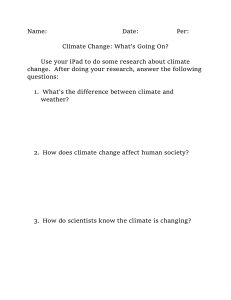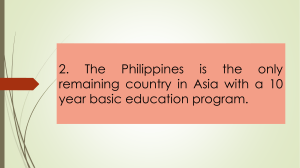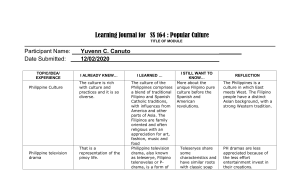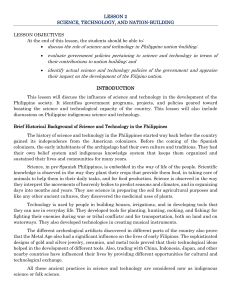Uploaded by
angelica edorot
Science, Technology, and Nation-Building in the Philippines
advertisement
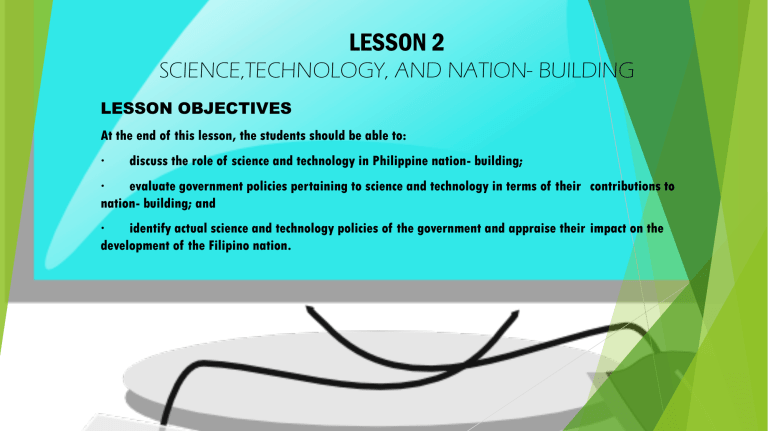
LESSON 2 SCIENCE,TECHNOLOGY, AND NATION- BUILDING LESSON OBJECTIVES At the end of this lesson, the students should be able to: · discuss the role of science and technology in Philippine nation- building; · evaluate government policies pertaining to science and technology in terms of their contributions to nation- building; and · identify actual science and technology policies of the government and appraise their impact on the development of the Filipino nation. BRIEF HISTORICAL BACKGROUND OF SCIENCE AND TECHNOLOGY IN THE PHILIPPINES ● PRE- SPANISH PHILIPPINES SCIENCE - scientific knowledge is observed in the way they plant their crops that provide them food, in taking care of animals to help them in their daily tasks, and for food. - they interpret the movements of heavenly bodies to predict seasons and climates, and organizing days into months and year. - they use science in preparing the soil for agricultural purposes and like any other ancient cultures, - they discovered the medicinal uses of plants. TECHNOLOGY - used by people in building houses, irrigations, and developing tools that they can use in everyday life. - they developed tools for planting, hunting, cooking, and fishing, for fighting their enemies during war or -for transportation, both on land and on waterways - also they developed in creating musical instruments. tribal conflicts; SPANIARDS -they established schools for boys and girls and introduced the concept of subjects and disciplines. - School of science and technology= is the beginning of formal science and technology in the country. SCIENCE - focuses on understanding different concepts related to the human body, plants, animals, and heavenly bodies TECHNOLOGY - they focused on using and developing house tools used in everyday life. THE GALLEON TRADE -The so-called Manila Galleon (“Nao de China” or “Nao de Acapulco”) brought porcelain, silk, ivory, spices, and myriad other exotic goods from China to Mexico in exchange for New World silver SUMMARY INTERNAL INFLUENCES ●Survival ●Culture ●Economic ●Activities EXTERNAL INFLUENCES ●Foreign Colonizers ●Trade with foreign Countries ●International Economic Demands Development of Science and Technology in the Philippines Government Policies on Science and Technology NATIONAL RESEARCH COUNCIL OF THE PHILIPPINES (NCRP) - promotes and supports fundamental or basic research for the continuing total improvement of the research capability of individual scientists or group of scientists. FOUR POLICIES THAT CONDUCTED NCRP: 1. Social Sciences, Humanities, Education, International Policies and Governance ●Integrating ASEAN awareness in basic education without adding to the curriculum ●Emphasizing teaching in the Mother Tongue ●Developing school infrastructure and providing for ICT broadband ●Local food security 2. Physics, Engineering and Industrial Research, Earth and Space, Sciences, and Mathematics ●Emphasizing degrees, licenses, and Employment ●Outright grants for peer monitoring ●Review of RA. 9184- Government Procurement Reform Act ●Harnessing science and technology as an independent mover of development 3. Medical, Chemical, and Pharmaceutical Sciences ●Ensuring compliance of drug- manufacturing firms with ASEAN- harmonized standards by full implementation of the Food and Drug Administration ● Creating an education council dedicated to standardization of pharmaceutical services and care ●Empowering foods and drug agencies to conduct evidence- based research as pool of ●Allocating two percent of the GDP to research ●Legislating a law supporting human genome projects 4.Biological Sciences, Agriculture, and Forestry ●Protecting and conserving biodiversity by full implementation of existing laws ●Use of biosafety and standard model by ASEAN countries ●Promoting indigenous knowledge systems and indigenous people’s conservation ●Formulation of common food and safety standards information National Goals International Treaty Legal Frameworks SCIENCE AND TECHNOLOGY ▪ Policies ▪ Programs ▪ Projects Social Needs, Issues, and Problems As shown in the diagram, the development of policies in science and technology is shaped or influenced by several variables; policies need to be aligned to national goals, consider international commitments based on legal frameworks, and respond to various social needs, issues, and problems. Policies are guides to direct all efforts to a goal of developing a scientifically advanced country. FAMOUS FILIPINOS IN THE FIELD OF SCIENCE 1. RAMON CABANOS BARBA - for his outstanding research on tissue culture in Philippine mangoes. 2. JOSEFINO CACAS COMISO- for his works on observing the characteristics of Antarctica by using satellite images. 3. JOSE BEJAR CRUZ JR.- known internationally in the field of electrical engineering; was elected as officer of the famous Institute of Electrical and Electronic Engineering. 4. LOURDES JANSUY CRUZ- notable for her research on sea snail venom. 5. FABIAN MILLAR DAYRIT- For his research on herbal medicine 6. RAFAEL DINEROS GUERRERO III - for his research on tilapia culture 7. ENRIQUE MAPUA OSTREA JR.- for inventing the meconium drugs testing 8. LILIAN FORMALEJO PATENA- For doing research on plant biotechnology 9. MARI- JO PANGANIBAN RUIZ – for being an outstanding educator and graph theorist 10. GREGORY LIGOT TANGONAN –for his research in the field of communications technology These Filipino scientists who are recognized in abroad: ● CAESAR A. SALOMA – an internationally renowned physicist ● EDGARDO GOMEZ – famous scientist in marine science ● WILLIAM PADOLINA – chemistry and president of National Academy of Science and Technology (NAST)- Philippines ● ANGEL ALCALA- marine science FACTORS THAT INFLUENCE THE DEVELOPMENT OF FILIPINO SCIENTISTS INDIVIDUAL INTERESTS IN SCIENCE FAMILY NATURAL ENVIRONMENT SCHOOL SCIENCE SCIENCE LABORATORIES (TEACHERS AND LEARNING ENVIRONMENT) (REAL- LIFE CONTEXT) FILIPINO SCIENTISTS ● Many of these Filipino scientists are products of good school science. It means they were taught and inspired by great teachers. Their interests in science started to manifest during their childhood years. Their natural environment ignited their curiosity to learn about the natural and physical environment. Schools and the laboratories where they studied and worked nurtured this.
